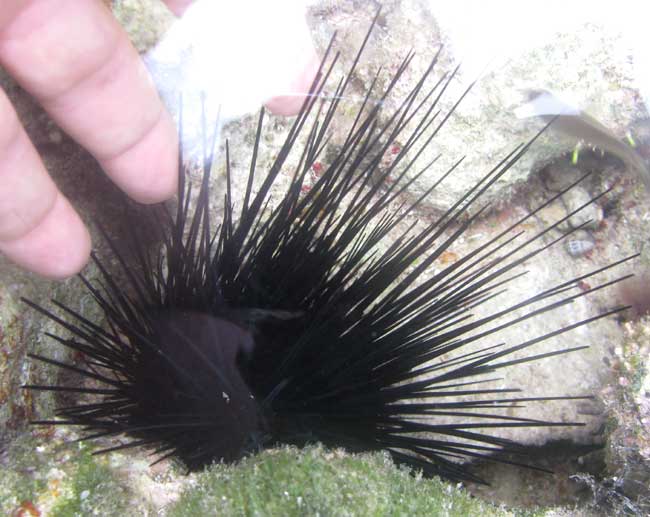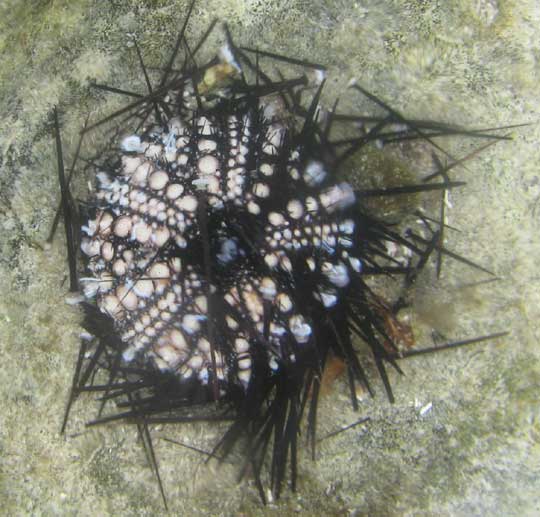Excerpts from Jim Conrad's
Naturalist Newsletter

from the June 26, 2011 Newsletter issued from Mayan Beach Garden Inn 20 kms north of Mahahual; Caribbean coastal beach and mangroves, ~N18.89°, ~W87.64°, Quintana Roo state, MÉXICO
A BLACK, LONG-SPINED SEA URCHIN
Especially when the tide is out, in tide pools you see a fair number of the Variegated Sea Urchins we profile at www.backyardnature.net/yucatan/urchin.htm. This week finally I saw a second species, one with black spines much longer than the Variegated's. You can see this new species underwater in a tide pool above.
Sea Urchins have a hard, Chinese-lantern-like interior skeleton technically referred to as a "test." When an urchin dies, its spines fall off exposing the test. In a pool not far from the one photographed above another of this black, long-spined species had recently died, and its test was just beginning to be revealed. You can see it, also submerged in shallow water, below:

Strangely, among rocks surrounding the tide pools where I found these two urchins, waves were depositing thousands of what looked like bleached spines of this same urchin species. I had no idea how to interpret this.
Back in Marcia's visitor library, Humann & Deloach's Reef Creature Identification: Florida, Caribbean, Bahamas quickly pointed me toward a species known variously as the Long-spined, Black, or Lime Sea Urchin, DIADEMA ANTILLARUM. Moreover, the essay accompanying the picture told a story that might explain the recently dead urchin and all those loose, bleached spines.
For, in the Caribbean, Long-spined Sea Urchins used to be the most common of all sea urchins. The species, because of its abundance, was very important for maintaining the health of coral reefs because Long-spined Sea Urchins ate algae that otherwise would cover the coral, choking it out.
Then in 1983 a yet unidentified disease killed about 93% of the Caribbean's Long-spined Sea Urchins, up to 99.9% in some areas. Consequently growth of coral in the region slowed or even reversed, and the fish and other animals living on coral reefs declined in numbers due to less food and shelter. I even read that this reduced biodiversity of the coral reefs affected tourism in several small countries, stressing their economies, because they depended on the natural beauty of their reefs to attract visitors. If you Google the keywords "Mass Mortality in Diadema antillarum" you'll get pages providing very detailed descriptions of the disaster.
Who knows if our dead sea urchin had died from that disease, and whether the bleached spines being heaped up by waves that day had anything to do with this disease? It's true that this is the first time since I've been here that I've come across a sea urchin who died so recently it was in the process of shedding its spines, and that I've seen such masses of discarded spines.
I read that in some areas Long-spined Sea Urchins are making a comeback.